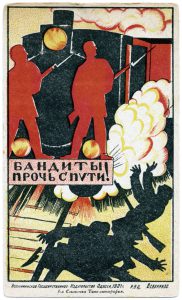A comprehensive postcard exhibition exploring the power of propaganda is on display at Boston’s Museum of Fine Arts (MFA) until January 2019.
With cutting slogans and bold colours, striking graphics and biting caricatures, postcards from the first half of the 20th century conveyed messages that were easily understood or remembered. Governments and other organizations adopted them as the perfect vehicle for propaganda to justify war, lionize leaders, demonize the enemy or underscore the need for citizens to make sacrifices for the cause.
Drawn from the Leonard A. Lauder Postcard Archive, a promised gift to the MFA, The Art of Influence: Propaganda Postcards from the Era of World Wars presents about 150 postcards from First World War through the end of Second World War—a time of conflict and upheaval on a global scale. It will be on display until Jan. 21, 2019.
“There is no better moment for this exhibition, which highlights the postcard as a masterful tool of persuasion,” said Lauder. “Though produced decades, some even a century, ago, the messages and designs still grab our attention, and in them we can see the roots of propaganda strategies employed today.”
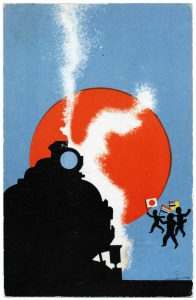
This card shows a Southern Manchuria Railway train greeted by children weaving national flags. (Photo by Museum of Fine Arts, Boston)
‘THE ART OF INFLUENCE’
The exhibition highlights postcards as both valuable historical tools and masterworks of graphic design. Whether produced by government propaganda bureaus, opportunistic publishers, aid organizations or resistance movements, they were designed to build and maintain public support as the world hurtled from one crisis to the next.
The Art of Influence explores a visual language shared by postcards from Europe, the Soviet Union, the U.S. and Japan. No matter their politics, various regimes used the same themes, including leaders, heroes, villains, fake news and mockery, to build and maintain public support. Additionally, the exhibition features selected posters and film clips that demonstrate the powerful and effective co-ordination of propaganda across a wide range of media. In doing so, it invites visitors to consider how politics and propaganda are intertwined—both in the context of the first half of the 20th century and today.
ILLUSTRATED ACCOMPANIMENT
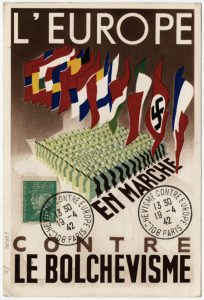
This French card shows ‘Europe on the Move against Bolshevism.’ (Photo by Museum of Fine Arts, Boston)
The Art of Influence is accompanied by The Propaganda Front: Postcards from the Era of World Wars, an illustrated volume produced by MFA Publications and authored by Anna Jozefacka, Lynda Klich, Juliana Kreinik and Benjamin Weiss.
“Postcards were ideal bearers of propaganda in the early decades of the 20th century, when the cards dashed through the mail in much the way that tweets and texts zip between people today,” said Benjamin Weiss, MFA director of collections and curator of visual culture. “The political messages and potent design carried by the cards have fascinated Leonard Lauder since he was a young man, and we are delighted to take this opportunity to show these particular cards at a time when the boundaries between political speech and propaganda are again at the center of public debate.”
The First World War marked a turning point in the relationship between art and politics, when modern war met modern communications technologies, and nations on all sides systematically used mass media to a degree they never had before. Postcards, which were ubiquitous by the turn of the 20th century, were ideal for disseminating propaganda. They were cheap to produce and purchase, and could be sent through the mail or handed out on the street. Propaganda artists in nearly every country refined a basic vocabulary of images that helped to convey simple messages—good vs. bad; forward vs. backward; and us vs. them. These stories could play out on multiple postcards, capitalizing on the impulse to collect and allowing for the use of repetition to reinforce ideas and perpetuate stereotypes and archetypes.
Heroic soldiers populate postcards from nearly all countries. The generic—and mostly male—figures invite viewers to imagine themselves in their role, pushing bravely forward to the front, as seen in “The Advance Continues” (1940, Gino Boccassile, published in Milan by the National Fascist Party), or standing stoically on sentry duty.
In “Soviets Resist the Nazi Invasion” (a late 1930s drawing attributed to Gustav Klutsis), the Soviet Union is embodied by a single heroic soldier, who stands firm against a German invasion. Enemies, on the other hand, were often portrayed as evil, foolish, grotesque and inhuman. At times, they were shown as harmless and not worthy of concern. During the Second World War, for example, artists in the U.S. showed violence in cartoon form, as seen in “Just a little something to ‘remember Pearl Harbor!'” (1942, Walt Munson, published in Boston by Tichnor Brothers). Humour provided a reassuring way of suggesting an attack happened at a safe distance, without individual human consequence.
Right wing or left, democratic, communist or fascist—artists and propagandists created a similar view of their leaders in the 1920s, ’30s and ’40s, depicting them as towering figures staring bravely into the unknown. Additionally, leaders wanted to demonstrate that they inherited or embodied the greatness of the past.
Postcards from the era show Joseph Stalin alongside his Soviet predecessor Vladimir Lenin as well as Adolf Hitler shaking hands with the spirit of Otto von Bismarck, who united Germany into one country in 1871. Alternatively turning a leader into a villain, a Christmas card produced by the Soviets in 1941—with, at least in part, an audience of German soldiers in mind—portrays Hitler as a false Santa Claus, suggesting he delivers only war, death and hunger.
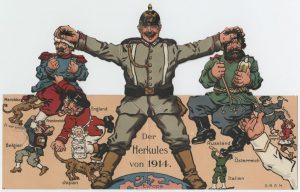
‘The Hercules of 1914’ is shown on this oversized pop-up card. (Photo by Museum of Fine Arts, Boston)
On the opposite end of the social scale, the everyman—or, less frequently, everywoman—also appeared in propaganda postcards, often engaged in a group activity. In Italy, images ranged from postcards showing a meal where the tables are arranged to spell out DUX (Mussolini’s title) to photos of the Fascist youth group Sons of the She Wolf. In Nazi propaganda, all Germans—especially children—are depicted as blond-haired, blue-eyed, smiling and vigorous. Meanwhile, in a Soviet postcard from about 1930, a single peasant woman looms larger than life, rising up against the clergy and the landowners. These two strategies of representation—the symbolic masses or the archetypal individual—offered identity and inspiration for the intended audiences.
The exhibition also features many postcards devoid of any people and instead uses symbols to carry out a message. Maps, for example, often stood in for entire nations, especially in times of war. “V for Victory” became a universal slogan during the Second World War—even in countries, like Germany, where the word for “victory” does not begin with “v.” A grouping of six postcards from Great Britain, the U.S., France, Germany and Italy illustrates how the “V” was used in tailored messages from country to country, often paired with national emblems.
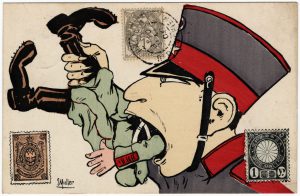
This card shows a Japanese doldier ‘devouring the Russian enemy.’ (Photo by Museum of Fine Arts, Boston)
LAUDER POSTAL ARCHIVE
The single most comprehensive collection of postcards in the world, the Lauder Postcard Archive was promised to the MFA in 2010, migrating from New York to Boston in annual installments.
The archive, which contains more than 110,000 postcards, spans the history of the medium, from its beginnings as a humble pre-paid postal card in 1869, through the enormous postcard craze of the 1890s and 1900s, to those produced in Second World War. The archive does contain some postwar cards, but the majority of its holdings date between 1890 and 1940.
Among its particular strengths are artists’ cards of the decades on either side of the turn of the 20th century; advertising cards; so-called mechanical cards, which have pull tabs and other moving parts; cards associated with politics and propaganda; and cards of ethnographic subjects, including large groups of cards from Africa.
The collection also includes an extensive group of cards—nearly 15,000—issued by the Detroit Publishing Company; it is a near complete collection of cards by this important publisher of U.S. view cards.


